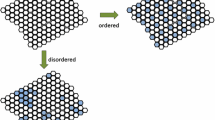Abstract
Multicellular organisms are ensembles of quasi-two-dimensional structures (sheets) of various kinds. Why should the development of all organisms be mediated by a quasi-two-dimensional structure? Why does such development avoid a direct confrontation with the third dimension? In this paper, we accept the challenge of addressing this question from the perspective of computational geometry and suggest that the construction of three-dimensional organisms may be explained by the constraints imposed on a bottom-up construction process.
Similar content being viewed by others
References
Bard J. (1990) Morphogenesis. Cambridge, Cambridge UP
Gilbert S.F. (2000) Developmental Biology. Sunderland, MA: Sinauer Associates Inc
Nelson W.R., Hirayama H., Rogers. D. (1985) The EGS4 Code System, SLAC-265.
Author information
Authors and Affiliations
Corresponding author
Rights and permissions
About this article
Cite this article
Neuman, Y., Orion, I. Why are Three-dimensional Organisms Composed of Two-dimensional Layers?. Found Sci 12, 1–7 (2007). https://doi.org/10.1007/s10699-006-9104-1
Published:
Issue Date:
DOI: https://doi.org/10.1007/s10699-006-9104-1




